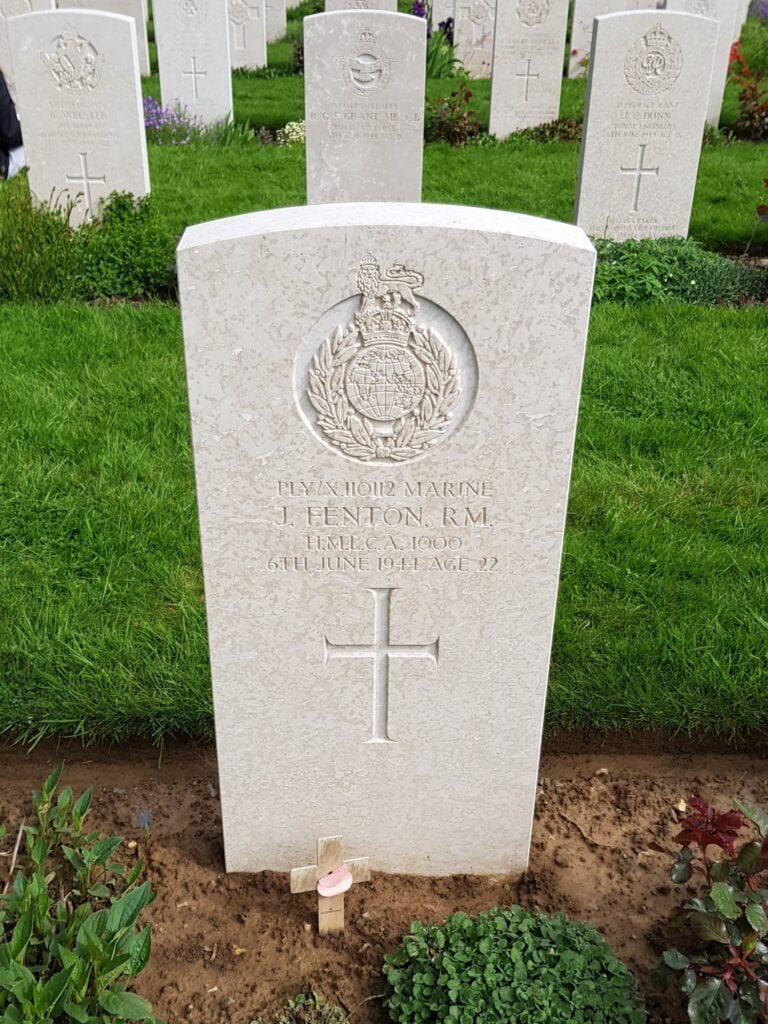For the first time, this Roll of Honour brings together the names of the crews of Allied landing craft and landing ships who died on D-Day and during the subsequent Normandy campaign. It is highly likely that future research – and comments from readers such as yourself – will bring new names to light, so the Roll of Honour should be considered a work in progress. Any feedback or additional information is welcomed. Read on to find out why I created the Roll of Honour, who is included and the sources used to compile it.

Above: The grave of Marine John Fenton of LCA 1000 in Bayeux War Cemetery. He died on 6 June 1944, at age 22, while serving with 541 Assault Flotilla, attached to SS Empire Mace. His craft was damaged beyond repair on its third beaching on D-Day, and he was one of three crew presumed to have been killed on that occasion.
Why I created this Roll of Honour
This Roll of Honour was created through the research for my book “D-Day Landing Craft”. In the course of preparing and writing the book I used a wide variety of sources, both original document and secondary material. These often mentioned landing craft crewmen who had been died as a result of their service.
Sometimes I did some quick further research on these individuals, either to help with what I was writing or just out of curiosity. I was struck by the fact that in many cases, the main websites recording the casualties of the Normandy Campaign did not identify these men as landing craft crewmen, or link them to a specific craft. Or they were linked to the wrong craft, for example because their flotilla number had been incorrectly used as the pennant/hull number of their craft. Often they were only described as sailors. Sometimes they had the wrong date of death.
I wanted to take the chance to put all these men’s stories in one place.
Who is included in the Roll of Honour?
- It includes Allied personnel of any nationality who were serving as landing craft crewmen and in related roles such as flotilla staff. All died during the Second World War, either in action, or at a later date of wounds inflicted in battle. A small number of men who died as a result of accidents rather than through enemy action are also included.
- The majority of individuals on the Roll of Honour were either British or American, and came from several different branches of each country’s armed forces.
- As well as individuals whose burial site or commemoration is in the care of the Commonwealth War Graves Commission or American Battle Monuments Commission, it also includes other individuals who were landing craft crewmen. The majority of the latter are US personnel whose bodies were repatriated and buried in the USA, and who therefore are not included in the ABMC’s records.
- “Landing craft” in this context also includes landing barges, landing ships such as the LST or LSI (and the latter’s US equivalent, the APA). Strictly speaking these were not landing craft. However both in 1944 and since they are often considered together, and were closely linked.
- Deaths amongst troops on board landing craft are not recorded here. Such information is not usually recorded in landing craft unit records, and would need considerable additional research in (primarily) army records to confirm, which I am not at present in a position to do. However if you are interested in a specific landing craft loss, you may find more information in the relevant army war diaries.
Using the Roll of Honour
Read an explanation of the columns (fields) used in the Roll of Honour.
Sources used
This Roll of Honour draws on a wide range of sources, which are gratefully acknowledged. Find out more here about the main sources used in this research.
How many landing craft crew died in the naval forces assigned to each beach for D-Day, and in the rest of the Normandy campaign?
These figures are based on on-going research. Find out more about this here.